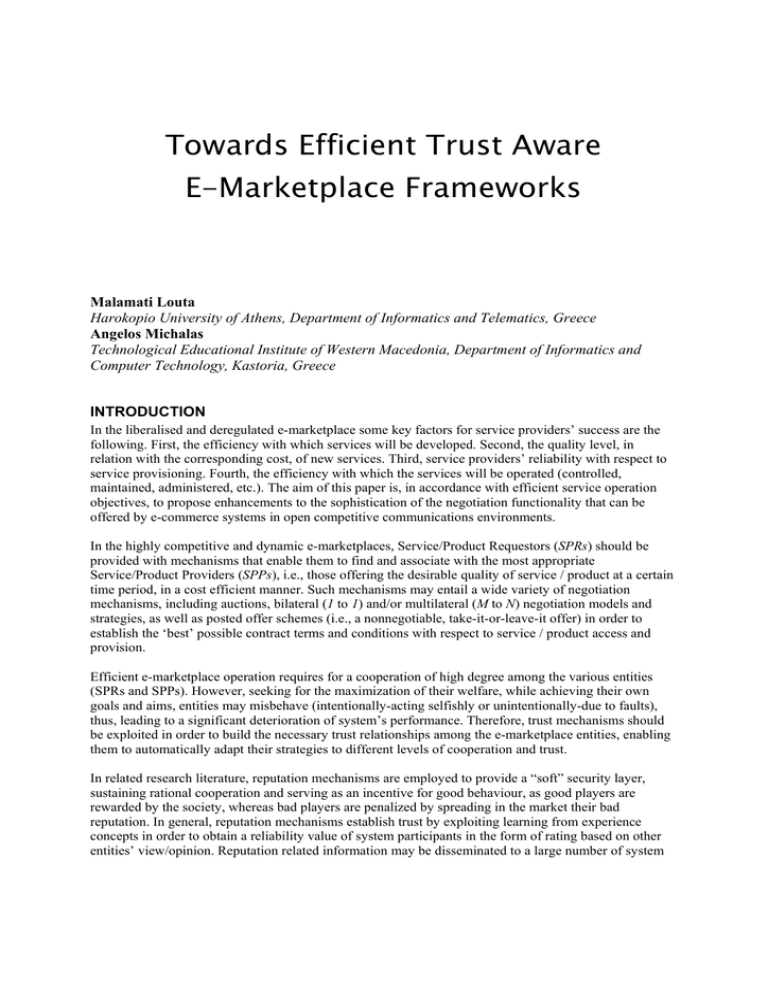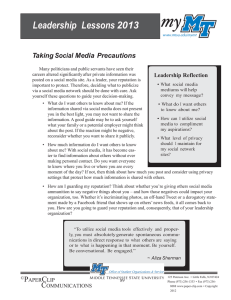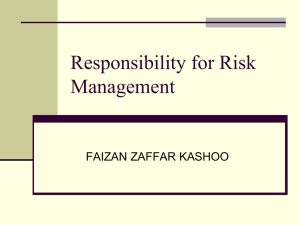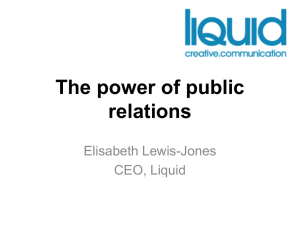Malamati Louta, Angelos Michalas, "Towards Efficient Trust Aware E
advertisement

Towards Efficient Trust Aware
E-Marketplace Frameworks
Malamati Louta
Harokopio University of Athens, Department of Informatics and Telematics, Greece
Angelos Michalas
Technological Educational Institute of Western Macedonia, Department of Informatics and
Computer Technology, Kastoria, Greece
INTRODUCTION
In the liberalised and deregulated e-marketplace some key factors for service providers’ success are the
following. First, the efficiency with which services will be developed. Second, the quality level, in
relation with the corresponding cost, of new services. Third, service providers’ reliability with respect to
service provisioning. Fourth, the efficiency with which the services will be operated (controlled,
maintained, administered, etc.). The aim of this paper is, in accordance with efficient service operation
objectives, to propose enhancements to the sophistication of the negotiation functionality that can be
offered by e-commerce systems in open competitive communications environments.
In the highly competitive and dynamic e-marketplaces, Service/Product Requestors (SPRs) should be
provided with mechanisms that enable them to find and associate with the most appropriate
Service/Product Providers (SPPs), i.e., those offering the desirable quality of service / product at a certain
time period, in a cost efficient manner. Such mechanisms may entail a wide variety of negotiation
mechanisms, including auctions, bilateral (1 to 1) and/or multilateral (M to N) negotiation models and
strategies, as well as posted offer schemes (i.e., a nonnegotiable, take-it-or-leave-it offer) in order to
establish the ‘best’ possible contract terms and conditions with respect to service / product access and
provision.
Efficient e-marketplace operation requires for a cooperation of high degree among the various entities
(SPRs and SPPs). However, seeking for the maximization of their welfare, while achieving their own
goals and aims, entities may misbehave (intentionally-acting selfishly or unintentionally-due to faults),
thus, leading to a significant deterioration of system’s performance. Therefore, trust mechanisms should
be exploited in order to build the necessary trust relationships among the e-marketplace entities, enabling
them to automatically adapt their strategies to different levels of cooperation and trust.
In related research literature, reputation mechanisms are employed to provide a “soft” security layer,
sustaining rational cooperation and serving as an incentive for good behaviour, as good players are
rewarded by the society, whereas bad players are penalized by spreading in the market their bad
reputation. In general, reputation mechanisms establish trust by exploiting learning from experience
concepts in order to obtain a reliability value of system participants in the form of rating based on other
entities’ view/opinion. Reputation related information may be disseminated to a large number of system
participants in order to adjust their strategies and behaviour, multiplying thus the expected future gains of
honest parties which bear the loss incurred by cooperating and acting for the maximization of the social
welfare. Current reputation system implementations consider feedback given by Buyers in the form of
ratings in order to capture information on Seller’s past behavior, while the reputation value is computed
as the sum (or the mean) of those ratings, either incorporating all ratings or considering only a period of
time (e.g., six months) (eBay), (OnSale).
In the context of this study, our focus is laid upon the evaluation of the reliability of SPPs. To this respect,
a collaborative reputation mechanism is presented and evaluated, which takes into account the SPPs’ past
performance in consistently satisfying the SPRs’ expectations. Specifically, the reputation mechanism
rates the SPPs with respect to whether they honoured or not the agreements established with the SPRs,
thus, introducing the concept of trust among the involved parties. The reputation mechanism considers
both first-hand information (acquired from the evaluator SPR’s past experiences with the target SPP) and
second-hand information (disseminated from other SPRs), is decentralized and exhibits robust behaviour
against inaccurate reputation ratings intentionally and/or unintentionally provided.
The rest of the paper is structured as follows. After briefly revisiting the related research literature, the
authors discuss on the fundamental concepts lying behind the design of the trust-aware framework. The
problem of cheating witnesses is described and the solution introduced is experimentally evaluated.
BACKGROUND
The issue of trust has been gaining an increasing amount of attention in a number of research
communities. In (Wang, 2008) the authors review the reputation-based trust evaluation mechanisms in
literature and outline some trust issues that are particularly important in e-commerce environments. In
(Josang, 2005) an overview on existing and proposed systems that can be used to derive measures of trust
and reputation for Internet based transactions is given, while current trends and developments are
analyzed. A general observation is that commercial systems so far utilize simple schemes, while academic
community proposes systems with advanced features, which however lack coherence, as there is no
consolidated set of well recognized principles for building trust and reputation systems.
In (Mui, 2003) a typology is proposed summarizing existing works on reputation across diverse
disciplines (i.e., economical studies, scientometrics, computer science, evolutionary biology, sociology).
Specifically, reputation is assumed to be context dependent, it can be viewed as global or personalized,
can be used to describe an individual or group of individuals. Individual reputation can be derived either
from direct encounters or/and observations made about other agent’s encounters with others (direct
reputation) or from inferences based on information gathered indirectly (indirect reputation) comprising
prior beliefs an agent has about strangers, reputation estimates of the group an agent belongs to and
information gathered according to a mechanism similar to the “word of mouth” propagation of
information for human. Based on this typology, the authors have studied the relative strengths of different
notions of reputation in a set of evolutionary games.
In (Sabater, 2001), reputation is considered to be a multi-faceted concept. Thus, it is built taking into
account individual, social and ontological dimensions. Specifically, an agent’s reputation is formed
considering previous direct interactions with the specific agent (individual reputation formation), the
interactions with the other members of the group to which the agent under evaluation belongs, the opinion
the group of the requesting agent has about the agent being evaluated, the opinion the group of the
requesting agent has about the group the agent being evaluated belongs (social reputation formation) and
reputation values on different aspects (ontological reputation formation).
In (Yu, 2000), the authors base the decision concerning the trustworthiness of a party on a combination of
local information acquired from direct interactions with the specific party (if available) and information
acquired from witnesses (trusted third parties that have interacted with the specific party in the past). In
order to obtain testimonies from witnesses, a trust net is built by seeking and following referrals from its
neighbours, which may be adaptively chosen. Their approach relies upon the assumption that the vast
majority of agents provide honest ratings, in order to override the effect of spurious ratings generated by
malicious agents. In (Yu, 2003), some models of deception are introduced and it is studied how to
efficiently detect deceptive agents following these models based on a variant of the weighted majority
algorithm applied to belief functions. In (Zhang, 2008), the authors present a model for evaluating
trustworthiness of advisor and seller agents aiming to handle effectively unfair ratings (both high and
low). Advisor and seller agent trustworthiness can be calculated exploiting both private and public
knowledge. Experimental results are provided demonstrating the performance of the proposed scheme
under diverse conditions with respect to the percentages of unfair ratings provided.
(Bachrach, 2009) presents a decentralized data management scheme grounded in gossip-based algorithms.
The proposed scheme motivates agents to maintain a high reputation value as its theoretical and empirical
(through simulation experiments) analysis shows that the higher an agent’s reputation is above a threshold
set by its peers, the more transactions it would be able to complete within a certain time unit.
In (Yolum, 2005), the authors study the guidelines for building self-organizing referral networks,
consisting of autonomous agents that model others in term of their trustworthiness and disseminate
information on others’ trustworthiness via simulation experiments for the e-commerce application
domain. The simulation findings yield interesting guidelines with respect to the selectivity of referrals
exchange.
(Xiong, 2005) introduces PeerTrust, an adaptive and dynamic reputation based trust model that helps
participants/peers to evaluate the trustworthiness of each other based on the community feedback about
participants’ past behavior. Regarding the credibility of the feedback source, the authors first used a
function of the trust value as its credibility value; that is feedback from trustworthy peers is considered
more credible. However, it is possible for a peer to maintain a good reputation by performing high quality
services but send malicious feedback to its competitors. In such a case the credibility factor is calculated
as a personalized similarity measure between the experiences with other partners in the market.
In general, various systems for trust establishment have been proposed, a number of which utilize the
opinion / view other system participants have on the entities under evaluation. Most of them aim to enable
entities to make decisions on which parties to negotiate/cooperate with or exclude, after they have been
informed about the reputation ratings of the parties of interest. The authors believe that the SPPs that are
deemed misbehaving should not be directly excluded / isolated, but instead the SPRs’ decision on the
most appropriate SPP should be on a weighted combination of the evaluation of the quality of the SPPs’
offer and of their reputation rating. Additionally, a number of related works do not clearly describe how
the evaluator entities find in the system feedback sources used for the overall evaluation of the target
entities. Furthermore, our mechanism in order to elicit true feedback considers intentional as well as
unintentional inaccurate information provisioning, taking into account, in addition to witness
trustworthiness, the number of transactions a witness SPR has performed with the target SPP and the sum
of the respective transactional values. Finally, in our framework, time effect has been taken into account
and more recent events weigh more in the evaluation of the overall reputation rating of the target entity,
while untrustworthy SPPs are given a chance to re-enter the system and improve their reputation rating in
case they abide by the established SLA terms and conditions.
TRUST-AWARE E-MARKETPLACE FRAMEWORK FUNDAMENTALS
Let us assume the presence of M SPPs offering n services / products in the e-marketplace and N SPRs
negotiating with SPPs at some points in time for the terms and conditions concerning the provisioning of
a service / product. In general, the SPRs can decide on the most appropriate SPPs based on an evaluation
of the SPPs’ offers quality combined with an estimation of the SPPs’ expected behaviour. The second
factor constitutes the SPPs reliability, which is introduced in order to reflect whether the SPPs finally
provide to the SPRs the service / product that corresponds to the established contract terms or not.
The study is based upon the notion of interacting intelligent agents which participate in trading activities
on behalf of their owners, while exhibiting properties such as autonomy, reactiveness, and proactiveness,
in order to achieve particular objectives and accomplish their goals. Thus, Service/ Product Requesting
Agent (SPRA) may be introduced and assigned with the role of capturing the SPR preferences,
requirements and constraints regarding the requested service / product, delivering them in a suitable form
to the appropriate SPP entity, acquiring and evaluating the corresponding SPPs’ offers, and ultimately,
selecting the most appropriate SPP on the basis of the quality of its offer and its reputation rating. Service
Product Provider Agents (SPPAs) are the entities acting on behalf of the SPPs. Their role would be to
collect the SPR preferences, requirements and constraints and to make a corresponding offer, taking also
into account certain environmental criteria. SPRAs and SPPAs are both considered to be rational and selfinterested and are, in principle, in conflict, aiming to maximise their owners’ profit.
A distributed collaborative reputation mechanism is exploited in order to assess SPPs reliability in an
accurate and time-efficient manner. In essence, SPPs reputation ratings are formed by SPRs, reflecting
whether in general SPPs abide by the agreement terms or not; the SPPs reliability is reduced whenever the
SPPs during service / product provisioning do not honour the contract terms reached via the negotiation
process. For the formation of SPPs reliability, the evaluator SPR agent utilises both locally stored
information (acquired from SPRA’s past experiences with SPPAs) as well as information retrieved form
other agents (i.e., witness - based approach).
The designed reputation mechanism is based on the following focal assumptions and principles:
A) Each SPRA keeps a record of the reputation ratings of the SPPAs it has negotiated with and has
been served in the past.
B) Each SPRA is willing to share its experiences and provide whenever asked for the reputation
ratings of the SPPAs, formed on the basis of its past direct interactions.
C) The SPPAs reputation ratings are estimated by an evaluator SPRA as a weighted combination of
two factors; the first factor constitutes the SPPAs reputation ratings as formed by the evaluator
SPRA on the basis of its direct experiences in the e-market, while the second factor contributing
to the overall reputation ratings estimation depends on information regarding SPPAs past
behaviour gathered from a number of witnesses.
D) The evaluator SPRA obtains potential witness references by contacting a central component,
hereafter noted as Reputation Broker. Specifically, in the current version of this study, the
Reputation Broker maintains a list of the SPPAs providing a specific service / product as well as a
list of SPRAs that have previously interacted with a specific SPPA.
E) The reliability of SPPs is treated as a behavioural aspect, independent of the services / products
provided. Thus, the witnesses list may be composed by SPRAs which have had direct interactions
with the specific SPPA in the past, without considering the service / product consumed, enabling
this way the formation of SPPs’ reliability in a time – efficient manner. Additionally, the SPRAs
will serve as witnesses for the estimation of the overall reputation of SPPAs, only in case they
have formed an accurate picture regarding SPPA’s reliability related behavioural aspects (e.g.,
they have been involved with the target SPPA for at least a pre-defined number of transactions, in
which case we assume that the learning period has been completed).
F) SPPAs have a solid interest in informing the Reputation Broker with respect to services / products
they currently offer, while the SPRAs are authorized to access and obtain witness references only
in case they send feedback concerning the preferred partner for their past interactions in the
system. This policy based approach provides a solution to the inherent incentive based problem of
reputation mechanisms in order for the Reputation Broker to keep accurate and up to date
information.
G) SPPAs reputation ratings are updated by SPRAs, only after a transaction has taken place,
exploiting learning from experiences techniques. Specifically, a reward/penalty function is
introduced, reflecting whether the service / product quality is compliant with the picture
established during the negotiation phase. The better /worse the SPPA behaves with respect to the
agreed terms and conditions, the more positive /negative the influence of the reward / penalty
function on the SPPA’s rating.
H) Initial SPPAs’ reliability rating values are taken equal to 0.1. A quite low reputation rating value
has been assumed (that is all SPPAs initially are considered to be dishonest entities) in order to
avoid the bad consequences of changing identities so as to wipe out possible misbehaviour in the
past.
I) A learning period is required in order for the SPRAs to obtain fundamental information for the
SPPAs. During the learning period and in case reputation specific information is not available to
the SPRA (both through its own experiences and through the witnesses) or it highly possible to be
outdated, the reliability related factor is not considered for the SPPA selection. Thus, the SPP’s
will be selected only on the basis of the quality of their offers (or even in a random or in a roundrobin basis).
J) Considering that the SPRAs have initially acquired the fundamental reliability related information
for the SPPAs (that is after the learning period), only the reputation rating of the “best” SPPA
(i.e., the one selected on the basis of the quality of the offers proposed to the SPRA and the
SPPAs’ reliability related values) will be updated, after the user finally accesses the service.
Thus, the system can only verify the behaviour of the “most” appropriate SPPA and has no means
to identify potential changes to other SPPAs’ behaviour with respect to their compliance to the
established contract terms and conditions.
K) In order to take into account new SPPAs that enter the system and/or not to exclude SPPAs that
initially did not honour the terms and conditions of the contracts established, thus being attributed
with a small reliability related value after the learning period, and give them a chance to re-enter
to the system and improve their reputation rating in case they abide by the contract terms and
conditions, the simplest possible approach that could be adopted is to base the SPRAs’ decision
concerning the most appropriate SPPA (after a specific time period, or after the completion of a
specific number of transactions) on the SPPAs’ performance and omit the SPPAs’ reputation
rating values until possible outdated information the system possesses is updated
L) The reputation mechanism comes at the cost of keeping reputation related information at each
SPRA and updating it after service provision / resource consumption has taken place.
M) The reliability rating value of the SPPAs requires in some cases (e.g., when consumption of
network or computational resources are entailed in the service provisioning process) a mechanism
for evaluating whether the service quality was compliant with the picture promised during the
negotiation phase.
Witness Cheating Behaviour : Challenges & Solutions
True feedback cannot be automatically assumed. Second-hand information can be spurious (e.g., parties
may choose to misreport their experience due to jealousy in order to discredit trustworthy providers or in
contrast to add credits to untrustworthy providers). In general, a mechanism for eliciting true feedback in
the absence of Trusted Third Parties or intermediaries is necessitated. According to the simplest possible
approach that may be adopted in order to account for possible inaccuracies to the information provided by
the witnesses SPRAs (both intentional and unintentional), the evaluator SPRA can mostly rely on its own
experiences rather on the target SPPA’s reputation ratings provided after contacting the SPRAs. To this
respect, SPPA’s reputation ratings provided by the witness SPRAs may be attributed with a relatively low
significance factor.
In the context of this study, we consider that in the eyes of the evaluator agent, each witness SPRA is
associated with a weighting factor dynamically updated, which reflects whether the SPRA provides
feedback with respect to its experiences with the SPPAs truthfully and in an accurate manner. In essence,
this weighting factor is a measure of the credibility of the witness information. To be more specific, in
order to handle intentional inaccurate information, an honesty probability is attributed to each SPRA, i.e.,
a measure of the likelihood that a SPRA gives feedback compliant to the real picture concerning service
provisioning. Trustworthiness of witnesses initially assumes a high value. That is all witnesses are
considered to report their experiences to the evaluator agent honestly. Potential dissemination of
misinformation on behalf of a witness is identified in case the overall SPPAs reputation rating as
estimated by the evaluator is beyond a given distance from the rating provided by the witness, in which
case its honesty probability is accordingly decreased. Second-hand information obtained from trustworthy
SPRAs (associated with a high honesty probability), are given a higher significance factor, whereas
reports (positive or negative) coming from untrustworthy sources have a small impact on the formation of
the SPPAs’ reputation ratings.
Concerning the provision of inaccurate information unintentionally, the authors take into account the
number of transactions a witness SPRA has performed with the target SPPA, the sum of the respective
transaction values and the time the last transaction has occurred. Specifically, it is quite safe to assume
that SPRAs that have been involved with the target SPPA only for a few times will not have formed an
accurate picture regarding its behaviour. Additionally, if the reputation rating is formed on the basis of
low-valued transactions, there is a possibility that it does not reflect the real picture (e.g., an SPPA may
strategically exhibit good behaviour in case its potential profits in a context of a transaction are low and
cheat when the expected earnings are high). In order to further improve the correctness of the reputation
ratings assessment, time effects have been introduced in our mechanism, modeling the fact that more
recent events should weigh more in the evaluation of the target SRPs overall reputation rating by the
evaluator. Thus, potential modifications of the SPPs behaviour in recent past are addressed.
EXPERIMENTAL RESULTS
The reputation framework with the assumption of honest feedback provision from the vast majority of the
witnesses has been evaluated by simulating interactions among self-interested SPRAs and SPPAs and has
performed well (Louta, 2008). In this study, our aim is to extensively test our framework and provide
indicative evidence of the efficiency of our proposed scheme, incorporating various degrees of witnesses’
misbehaviour.
We hereafter assume the existence of an area that falls into the domain of M=10 candidate Service /
Product Providers P = {P1 , P2 ,...PM } (that is a specific request may be handled by any of the candidate
SPPs belonging to the set P). Furthermore, it is assumed that N=1000 different Service/Product
Requestors access the area.
In order to evaluate SPPs’ reliability, each SPP has been associated with a reliability probability, i.e., a
measure of the likelihood that the SPP delivers the service in accordance with the agreement established.
This probability has been set to the following values: 0.1 for SPPA P1 , 0.2 for SPPA P2 (i.e.,), 0.3 for
SPPA P3 , 0.4 for SPPA P4 , 0.5 for SPPA P5 , 0.6 for SPPA P6 , 0.7 for SPPA P7 , 0.8 for SPPA P8 and
0.9 for SPPA P9 and 1 for SPPA P10 . A mixture of extreme and moderate values has been chosen in
order to test the schemes under diverse conditions. In essence, with probability 0.1 SPPA P1 complies
with its promises, while P9 maintains its promises with probability 0.9.
Figure 1 illustrates the reputation ratings of each SPPA, as estimated after 100 transactions have taken
place between the evaluator SPRA & each witness SPRA and the SPPA under evaluation. The number of
witnesses is taken equal to 100 and all witnesses are assumed to behave honestly (that is, they provide the
evaluator SPRA with the actual reputation rating).
Figure 1. SPPs’ Reputation Rating Estimation, considering honest feedback provisioning from 100
witnesses.
In the sequel, we incorporated witness cheating behaviour in our framework, gradually increasing the
portion of misbehaving witnesses (that is the witnesses returning false feedback to the evaluator agent) as
well as the distance of the false feedback from the actual rating as formed by each witness SPRA on the
basis of its direct experiences with the SPPAs. Specifically, we have considered 10%, 30% and 50% of
the witnesses providing inaccurate reputation related information to the evaluator agent, varying in each
case the distance of the inaccurate rating from the actual rating to 10%, 30% and 50% (both incrementally
and decrementally).
Figure 2 presents the mean deviation for all SPPAs of the estimated SPPAs’ rating with respect to the
actual one for each of the aforementioned cases (blue line series). For the SPPAs’ reputation rating
estimation, as a first step witness trustworthiness assumes its initial value and is not dynamically modified
(that is all witnesses are in the eyes of the evaluator agent behaving honestly, even if this is not the case).
As a next step, the evaluator agent identifies the misbehaving witnesses and dynamically updates the
respective weighting factor taken into account in the SPPA’s rating estimation. The deviation of the
estimated SPPAs’ rating with respect to the actual one for the cases of 30% and 50% misbehaving
witnesses each with 30% and 50% feedback modification (distance of the inaccurate rating from the
actual rating) with respect to the actual one is presented in the red line series.
As may be observed, the mean deviation of the SPPAs’ reputation rating estimation from the actual rating
from 15% (in the case of 50% misbehaving witnesses with feedback modification 30% without dynamic
modification of witness trustworthiness) drops to approximately 3%, when adjusting their honesty
probability. The same stands for the case of 50% misbehaving witnesses with feedback modification 50%
where the mean deviation drops from 25% to 4,55%.
Figure 2. SPPs’ Reputation Rating Estimation, considering honest feedback provisioning from
100 witnesses
CONCLUSION
E-marketplaces are highly dynamic and variable environments characterized by at any time and no cost
associated emergence and disappearance of various actors, players’ anonymity, participation in only a few
transactions that may be of relatively low value, and difficulty of legal contract enforcement as potential
contracts may cross jurisdictional boundaries. In general, parties’ misbehaviour due to selfish or
malicious reasons can significantly degrade the performance of the e-market. To cope with misbehaviour
the parties should be able to automatically adapt their strategies to different levels of cooperation and
trust. Reputation mechanisms are employed to provide a “soft” security layer, introducing incentives for
good behaviour.
In this study, a reputation mechanism is proposed which helps estimating Service Product Providers
(SPPs) trustworthiness and predicting their future behaviour, taking into account their past performance in
consistently satisfying Service Product Requestors (SPRs) expectations in e-marketplace environments.
Specifically, SPPs are rated with respect to whether they honoured or not the agreements they have
established with the SPRs. The reputation mechanism is distributed, considers both first-hand information
and second-hand information, while it exhibits a robust behaviour against inaccurate reputation ratings.
Our aim is to provide indicative evidence of the efficiency of our proposed reputation framework,
especially in case of unfair ratings (witnesses cheating behaviour), simulating interactions among selfinterested autonomous intelligent agents. Future plans involve our frameworks’ extensive empirical
evaluation against existent reputation models and trust frameworks.
REFERENCES
eBay, http://www.ebay.com
OnSale, http://www.onsale.com/exchange.htm
Wang, Y., & Lin, K-J. (2008). Reputation-Oriented Trustworthy Computing in E-Commerce
Environments. IEEE Internet Computing, 12(4), 55-59.
Josang, A., Ismail, R., & Boyd, C. (2005). A survey of trust and reputation systems for online service
provision. Decision Support Systems, 43, 618-644.
Mui, L., Halberstadt, A., & Mohtashemi, M. (2003). Evaluating Reputation in Multi-Agent Systems. In R.
Falcone et al. (Eds), Trust, Reputation, and Security: Theories and Practice, LNAI: Vol. 2631 (pp. 123137). Berlin Heidelberg: Springer-Verlag.
Sabater, J., & Sierra C. (2001). REGRET: Reputation in gregarious societies. In Proc. of the 5th
International Conference on Autonomous Agents (pp. 194-195), Montreal, Quebec, Canada.
Yu, B., & Singh, M. (2000). A social mechanism of reputation management in electronic communities. In
Klusch, M., Kerschberg, L. (Eds.) Cooperative Information Agents IV - The Future of Information Agents
in Cyberspace, LNCS: Vol. 1860 (pp. 154-165). Berlin Heidelberg: Springer-Verlag.
Yu, B., & Singh, M. (2003). Detecting Deception in Reputation Management. In Proc. of the 2nd
International Joint Conference on Autonomous Agents and Multi-Agent Systems (pp. 73-80), Melbourne,
Australia.
Zhang, J., & Cohen R. (2008). Evaluating the trustworthiness of advice about seller agents in emarketplaces: A personalized approach. Electronic Commerce Research and Applications, 7, 330-340.
Bachrachm Y., Parnes A., Procaccia A., & Rosenschein J. (2009). Gossip-based aggregation of trust in
decentralized reputation systems. Autonomous Agents and Multi-Agent Systems, 19, 153-172.
Yolum, P., & Singh M. (2005). Engineering Self-Organizing Referral Networks for Trustworthy Service
Selection. IEEE Transactions on Systems, Man, and Cybernetics-Part A: Systems and Humans, 35(3),
396-407.
Xiong, L. & Liu, L. (2005). Reputation and Trust, In W.-C. Hu et al;(Eds.), Advances in Security and
Payment Methods for Mobile Commerce (pp. 19-35), Idea Group Inc.
Louta, M. (2008). Towards a Collaborative Reputation Based Service Provider Selection in Ubiquitous
Computing Environments. In F.E. Sandnes et al. (Eds.), UIC 2008, LNCS: Vol. 5061 (pp. 520-534).
Berlin Heidelberg: Springer-Verlag.
KEY TERMS & DEFINITIONS
E-marketplace Frameworks: The entities and processes enabling buying and selling of products
or services over electronic systems, such as the Internet and other computer networks.
Trust Management: Trust management can be conceptualized in two ways. First, as a process
according to which an entity becomes trustworthy for other entities. Second, as a process that
enables the assessment of the reliability of other entities, which in turn is exploited in order to
automatically adapt its strategy and behaviour to different levels of cooperation and trust.
Mobile Intelligent Agent Technology: Intelligent mobile agents are software components
incorporating intelligent functionality that can at a certain point in time migrate in order to
perform a specific task.
Reliability Evaluation: The process of determining whether an existing system / entity has
achieved a specified level of operational reliability (desired, agreed upon or contracted
behaviour).
Distributed & Collaborative Reputation Mechanisms: Reputation mechanisms establish trust by
exploiting learning from experience concepts in order to obtain a reliability value of system
participants in the form of ratings. Collaborative algorithms attempt to determine ratings for a
collection of entities, given a collection of opinions that those entities hold about each other.




